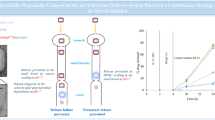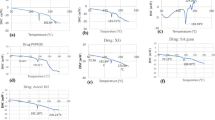Abstract
The objectives were to characterize propranolol hydrochloride-loaded matrix tablets using guar gum, xanthan gum, and hydroxypropylmethylcellulose (HPMC) as rate-retarding polymers. Tablets were prepared by wet granulation using these polymers alone and in combination, and physical properties of the granules and tablets were studied. Drug release was evaluated in simulated gastric and intestinal media. Rugged tablets with appropriate physical properties were obtained. Empirical and semi-empirical models were fit to release data to elucidate release mechanisms. Guar gum alone was unable to control drug release until a 1:3 drug/gum ratio, where the release pattern matched a Higuchi profile. Matrix tablets incorporating HPMC provided near zero-order release over 12 h and erosion was a contributing mechanism. Combinations of HPMC with guar or xanthan gum resulted in a Higuchi release profile, revealing the dominance of the high viscosity gel formed by HPMC. As the single rate-retarding polymer, xanthan gum retarded release over 24 h and the Higuchi model best fit the data. When mixed with guar gum, at 10% or 20% xanthan levels, xanthan gum was unable to control release. However, tablets containing 30% guar gum and 30% xanthan gum behaved as if xanthan gum was the sole rate-retarding gum and drug was released by Fickian diffusion. Release profiles from certain tablets match 12-h literature profiles and the 24-h profile of Inderal® LA. The results confirm that guar gum, xanthan gum, and HPMC can be used for the successful preparation of sustained release oral propranolol hydrochoride tablets.








Similar content being viewed by others
REFERENCES
Snow V, Weiss K, Wall EM, Mottur-Pilson C. Pharmacologic management of acute attacks of migraine and prevention of migraine headaches. Ann Intern Med. 2002;137:840–9.
Carroll JD, Reidy M, Savundra PA, Cleave N, McAinsh J. Long-acting propranolol in the prophylaxis of migraine: a comparative study of two doses. Cephalalgia. 1990;10:101–5.
Rajesh KS, Venkataraju MP, Gowda DV. Effect of hydrophilic natural gums in formulation of oral-controlled release matrix tablets of propranolol hydrochloride. Pak J Pharm Sci. 2009;22:211–9.
Rekhi GS, Porter SC, Jambhekar SS. Factors affecting the release of propranolol hydrochloride from beads coated with aqueous polymeric dispersion. Drug Dev Ind Pharm. 1995;21:709–12.
Sahoo J, Murthy PN, Biswal S, Sahoo SK, Mahapatra AK. Comparative study of propranolol hydrochloride release with Kollidon®SR or hydroxypropylmethyl cellulose. AAPSPharmSciTech. 2008;9(2):577–82.
Dabbagh MA, Ford JL, Rubinstein MH, Hogan JE, Rajabi-Siahboomi AR. Release of propranolol hydrochloride from matrix tablets containing sodium carboxymethyl cellulose and hydroxypropylmethyl cellulose. Pharm Dev Technol. 1999;4(3):313–24.
Velasco-De-Paola MVR, Santoro MIRM, Gai MN. Dissolution kinetics evaluation of controlled-release tablets containing propranolol hydrochloride. Drug Dev Ind Pharm. 1999;25:535–41.
Ford JL, Rubinstein MH, Hogan JE. Propranolol hydrochloride and aminophylline release from matrix tablets containing hydroxypropylmethylcellulose. Int J Pharm. 1985;24:339–50.
McAinsh J, Baber NS, Holmes BF, Young J, Ellis SH. Bioavailability of sustained release propranolol formulations. Biopharm Drug Dispos. 1981;2:39–48.
Ravi PR, Kotreka UK, Saha RN. Controlled release matrix tablets of zidovudine: effect of formulation variables on the in vitro drug release kinetics. AAPS Pharm SciTech. 2008;9(1):302–13.
Verhoeven E, Vervaet C, Remon JP. Xanthan gum to tailor drug release of sustained-release Ethylcellulose mini-matrices prepared via hot-melt extrusion: in vitro and in vivo evaluation. Eur J Pharm Biopharm. 2006;63:320–30.
Tahara K, Yamamoto K, Nishihata T. Overall mechanism behind matrix sustained release (SR) tablets prepared with hydroxypropyl methylcellulose 2910. J Control Rel. 1995;35:59–66.
Sujja-areevath J, Munday DL, Cox PJ, Khan KA. Relationship between swelling, erosion and drug release in hydrophilic natural gum mini-matrix formulations. Eur J Pharm Sci. 1998;6:207–17.
Baveja SK, Ranga Rao KV, Padmalatha Devi K. Zero-order release hydrophilic matrix tablets of β-adrenergic blockers. Int J Pharm. 1987;39:39–45.
Ranga Rao KV, Padmalatha Devi K, Buri P. Influence of molecular size and water solubility of the solute on its release from swelling and erosion controlled polymeric matrices. J Control Rel. 1990;12:133–41.
Kotadiya R, Patel V, Patel H. Comparative evaluation study of matrix properties of natural gums and semi-synthetic polymer. J Pharm Res. 2008;1:208–14.
Dhopeshwarkar V, Zatz JL. Evaluation of xanthan gum in the preparation of sustained release matrix tablets. Drug Dev Ind Pharm. 1993;19:999–1017.
Al-Saidan SM, Krishnaiah YSR, Patro SS, Satyanaryana V. In vitro and in vivo evaluation of guar gum matrix tablets for oral controlled release of water-soluble diltiazem hydrochloride. AAPSPharmSciTech. 2005;6(1):E14–21.
Chaplin M. Water structure and behavior: guar gum. London: South Bank University; 2006.
Altaf SA, Yu K, Parasrampuria J, Friend DR. Guar gum based sustained release diltiazem. Pharm Res. 1998;15:1196–201.
Khullar P, Khar RK, Agarwal SP. Evaluation of guar gum in the preparation of sustained release matrix tablets. Drug Dev Ind Pharm. 1998;24:1095–9.
Krishnaiah YSR, Karthikeyan RS, GouriSankar V, Satyanarayana V. Three-layer guar gum matrix tablet formulations for oral controlled delivery of highly soluble trimetazidine dihydrochloride. J Control Rel. 2002;81:45–56.
Varshosaz J, Tavakoli N, Kheirolahi F. Use of hydrophilic natural gums in formulation of sustained-release matrix tablets of tramadol hydrochloride. AAPS PharmSciTech. 2006; 7(1): Article 24.
Ford JL, Rubinstein MH, Hogan JE. Formulation of sustained release promethazine hydrochloride tablets using hydroxypropyl-methylcellulose matrices. Int J Pharm. 1985;24:327–38.
Wan LSC, Heng PWS, Wong LF. Relationship between swelling and drug release in a hydrophilic matrix. Drug Dev Ind Pharm. 1993;19:1201–10.
Merchant HA, Shoaib HM, Tazeen J, Yousuf RI. Once-Daily tablet formulation and in vitro release evaluation of cefpodoxime using hydroxypropyl methylcellulose: a technical note. AAPS PharmSciTech. 2006; 7(3): Article 78.
Lapidus H, Lordi NG. Drug release from compressed hydrophilic matrices. J Pharm Sci. 1968;57:1292–301.
Lapidus H, Lordi NG. Some factors affecting the release of a water soluble drug from a compressed hydrophilic matrix. J Pharm Sci. 1966;55:840–3.
Sujja-areevath J, Munday DL, Cox PJ, Khan KA. Release characteristics of diclofenac sodium from encapsulated natural gum mini-matrix formulations. Int J Pharm. 1996;139:53–62.
Solinís MA, De La Cruz Y, Calvo B, Hernández RM, Gascón AR, Goñi I, et al. Release of salbutamol sulfate and ketoprofen enantiomers from matrices containing HPMC and cellulose derivatives. Chirality. 2002;14:806–13.
Talukdar MM, Kinget R. Comparative study on xanthun gum and hydroxypropylmethyl cellulose as matrices for controlled-release drug delivery. II. Drug diffusion in hydrated matrices. Int J Pharm. 1997;151:99–107.
Peppas NA, Sahlin JJ. A simple equation for the description of solute release. III. Coupling of diffusion and relaxation. Int J Pharm. 1989;57:169–72.
Raja Sekharan T, Palanichamy S, Shanmuganathan S, Karthikeyan A, Senthilkumar SR, Thanga Thirupathi A. Formulation and evaluation of theophylline controlled release matrix tablets using xanthan gum. Der Pharmacia Lettre. 2009;1:93–101.
Mohammadi-Samani S, Adrangui M, Siahi-Shadbad MR, Nokhodchi A. An approach to controlled-release dosage form of propranolol hydrochloride. Drug Dev Ind Pharm. 2000;26:91–4.
Gohel MC, Parikh RK, Brahmbhatt BK, Shah AR. Improving the tablet characteristics and dissolution profile of ibuprofen by using a novel coprocessed superdisintegrant: a technical note. AAPS PharmSciTech. 2007; 8(1): Article 13.
Kumar V, Kothari SH, Banker GS. Compression, compaction, and disintegration properties of low crystallinity celluloses produced using different agitation rates during their regeneration from phosphoric acid solutions. AAPS PharmSciTech. 2001; 2(2): Article 7.
Carr RL. Classifying flow properties of solids. Chem Eng. 1965;72:69–72.
Korsmeyer RW, Gurny R, Doelker E, Buri P, Peppas NA. Mechanisms of solute release from porous hydrophilic polymers. Int J Pharm. 1983;15:25–35.
Ritger PL, Peppas NA. A simple equation for description of solute release. I. Fickian and non-Fickian release from non-swellable devices in the form of slabs, spheres, cylinders or discs. J Control Rel. 1987;5:23–36.
Higuchi T. Mechanism of sustained-action medication. Theoretical analysis of rate of release of solid drugs dispersed in solid matrices. J Pharm Sci. 1963;52:1145–9.
Higuchi T. Release rate of medicaments from ointment bases containing drugs in suspension. J Pharm Sci. 1961;50:874–5.
Desai SJ, Simonelli AP, Higuchi WI. Investigation of factors influencing release of solid drug dispersed in inert matrices. J Pharm Sci. 1965;54:1459–64.
Carstensen JT. Pharmaceutical principles of solid dosage forms. Lancaster: Technomic; 1993.
Siepmann J, Peppas NA. Mathematical modeling of controlled drug delivery. Adv Drug Deliv Rev. 2001;48:137–8.
Siepmann J, Peppas NA. Modeling of drug release from delivery systems based on hydroxypropyl methylcellulose (HPMC). Adv Drug Deliv Rev. 2001;48:139–57.
Bidah D, Vergnaud JM. Kinetics of in vitro release of sodium salicylate dispersed in Gelucire. Int J Pharm. 1990;58:215–20.
Brossard C, Lefort des Ylouses D, Duchene D, Puisieux F, Carstensen JT. Dissolution of a soluble drug substance from vinyl polymer matrices. J Pharm Sci. 1983;72:162–9.
Papadopoulou V, Kosmidis K, Vlachou M, Macheras P. On the use of the Weibull function for the discernment of drug release mechanisms. Int J Pharm. 2006;309:44–50.
Upadrashta SM, Katikaneni PR, Hileman GA, Keshary PR. Direct compression controlled release tablets using ethylcellulose matrices. Drug Dev Ind Pharm. 1993;19:449–60.
Pather SI, Russell I, Syce JA, Neau SH. Sustained release theophylline tablets by direct compression. Part 1. Formulation and in vitro testing. Int J Pharm. 1998;164:1–10.
Yamaoka K, Nakagawa T, Uno T. Application of Akaike’s Information Criterion (AIC) in the evaluation of linear pharmacokinetic equations. J Pharmacokinet Biopharm. 1978;6:165–75.
Prema R, Jeevanandham S, Sekar M, Rajkumar T, Dhachinamoorthi D, Chandra Sekhar KB, et al. Studies on fabrication of baclofen sr matrix tablets: in-vitro release pattern overview. Res J Pharm Biol Chem Sci. 2010;1:70–7.
Ubrich N, Bouillot P, Pellerin C, Hoffman M, Maincent P. Preparation and characterization of propranolol hydrochloride nanoparticles: a comparative study. J Control Rel. 2004;97:291–300.
Talukdar MM, Plaizier-Vercammen J. Evaluation of xanthan gum as a hydrophilic matrix for controlled release dosage form preparation. Drug Dev Ind Pharm. 1993;19:1037–46.
Bhalla H, Sanzgiri YD. An improved controlled release tablet of salbutamol sulphate. Ind J Pharm Sci. 1987;49:22–5.
Casas JA, Mohedano AF, Garcia-Ochoa F. Viscosity of guar gum and xanthan/guar gum mixture solutions. J Sci Food Agric. 2000;80:1722–7.
Billa N, Yuen K-H. Formulation variables affecting drug release from xanthan gum matrices at laboratory scale and pilot scale. AAPS PharmSciTech. 2000; 1: Article 30.
Neau SH, Chow MY, Durrani MJ. Fabrication and characterization of extruded and spheronized beads containing Carbopol® 974P, NF resin. Int J Pharm. 1996;131:47–55.
Khouryieh HAM. Rheological characterization of xanthan-guar mixtures in dilute solutions [dissertation]. Manhattan: Kansas State University; 2006.
Moore JW, Flanner HH. Mathematical comparison of dissolution profiles. Pharm Tech. 1996;20:64–74.
Draganoiu ES. Evaluation of Kollidon® SR for pH-independent extended release matrix systems [dissertation]. Cincinnati: University of Cincinnati; 2003.
Author information
Authors and Affiliations
Corresponding author
Rights and permissions
About this article
Cite this article
Mughal, M.A., Iqbal, Z. & Neau, S.H. Guar Gum, Xanthan Gum, and HPMC Can Define Release Mechanisms and Sustain Release of Propranolol Hydrochloride. AAPS PharmSciTech 12, 77–87 (2011). https://doi.org/10.1208/s12249-010-9570-1
Received:
Accepted:
Published:
Issue Date:
DOI: https://doi.org/10.1208/s12249-010-9570-1




